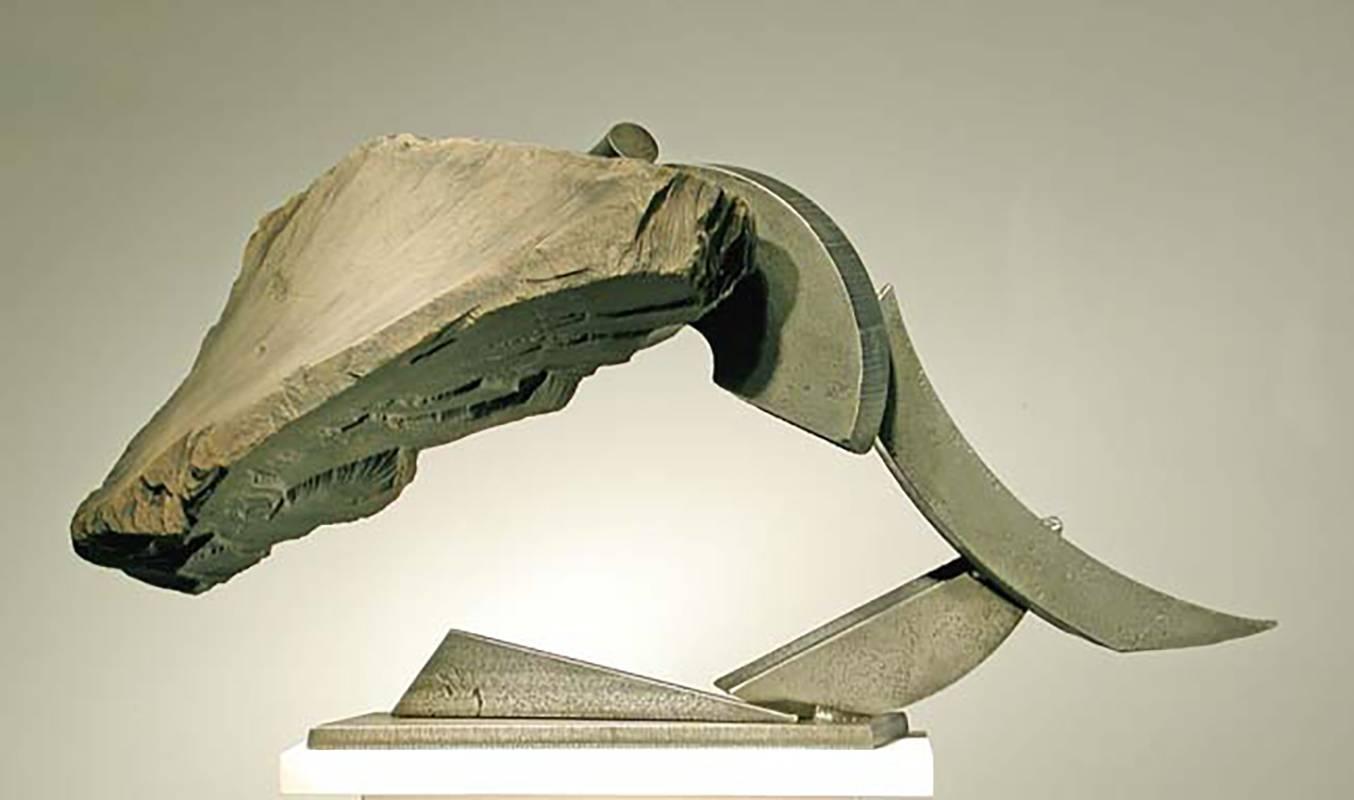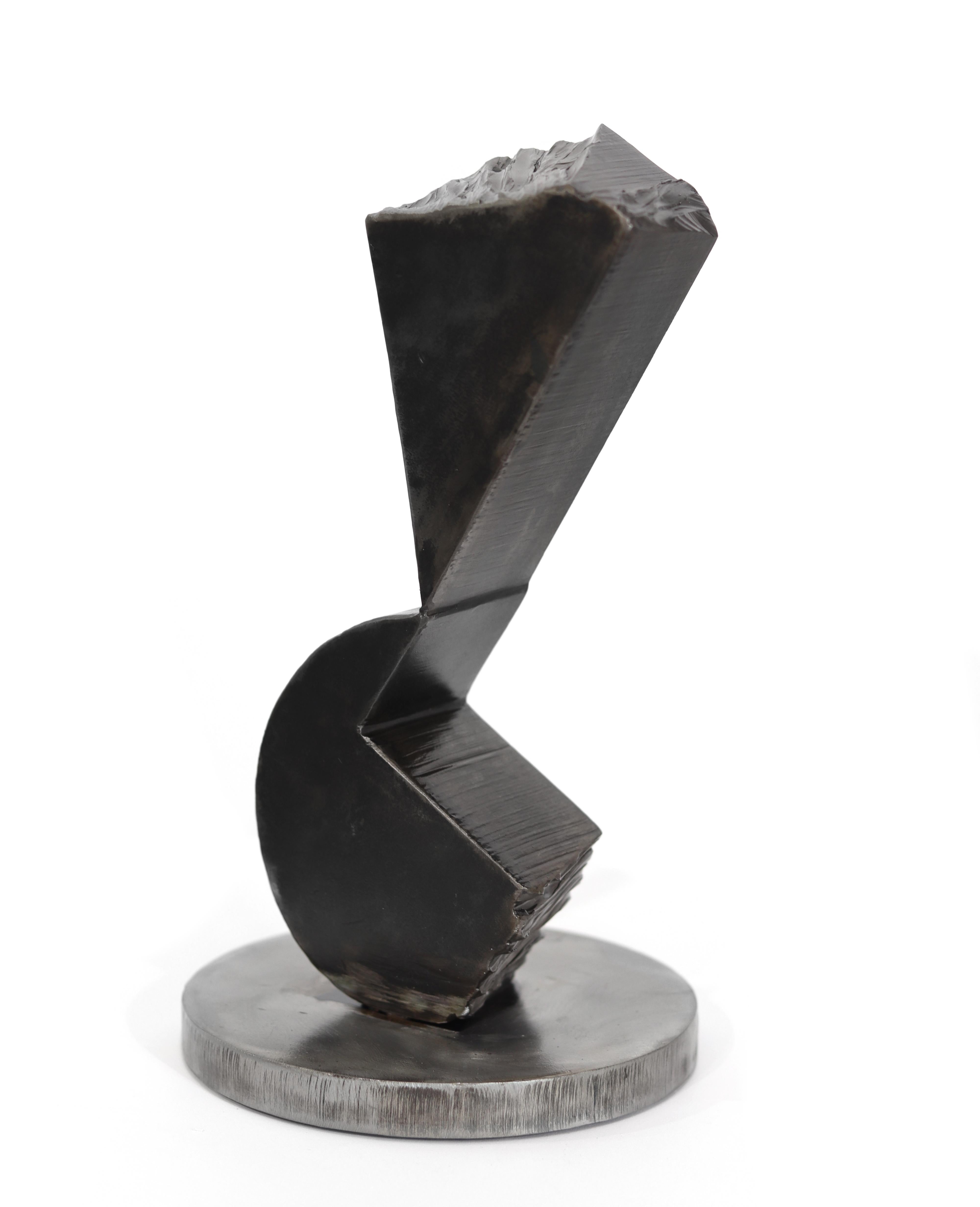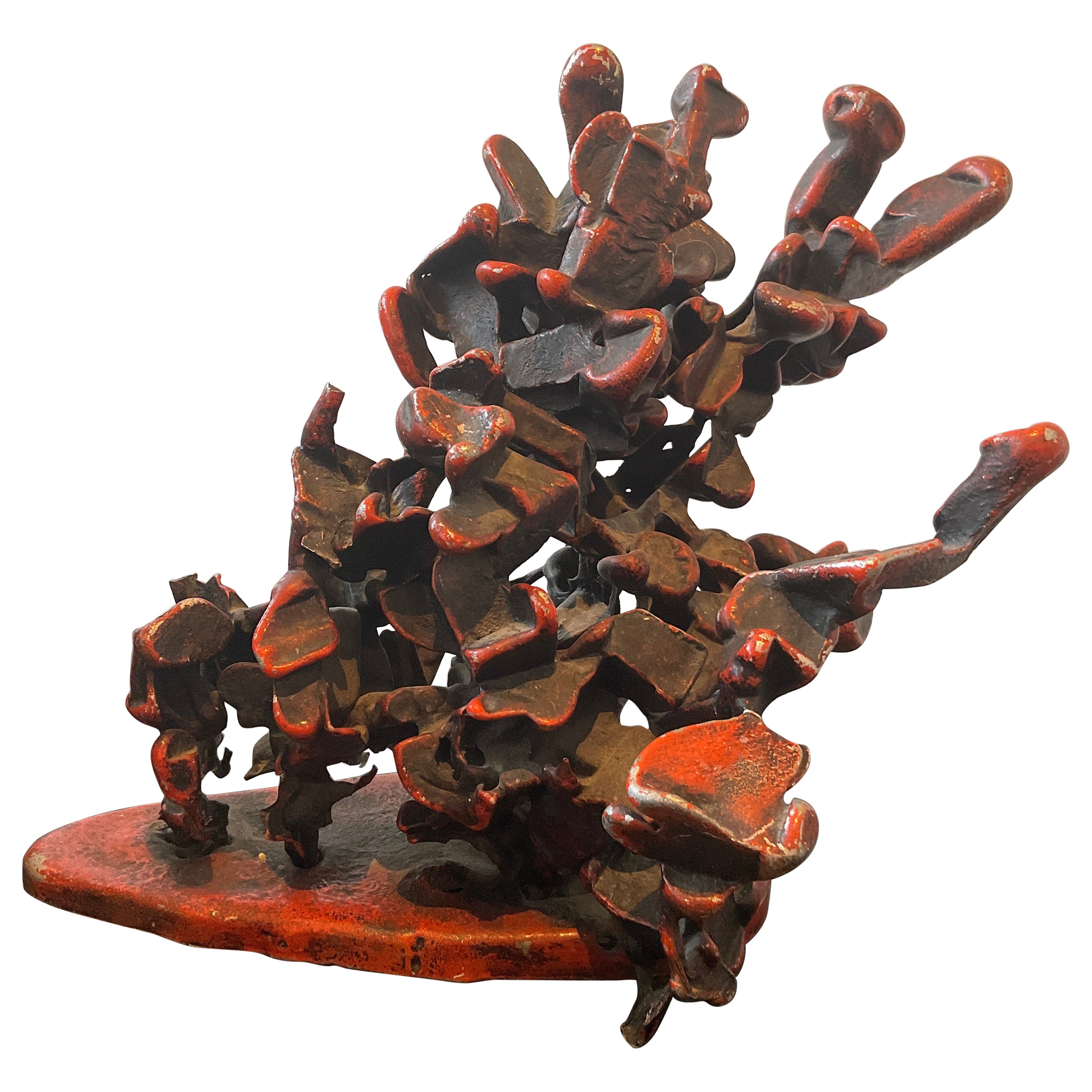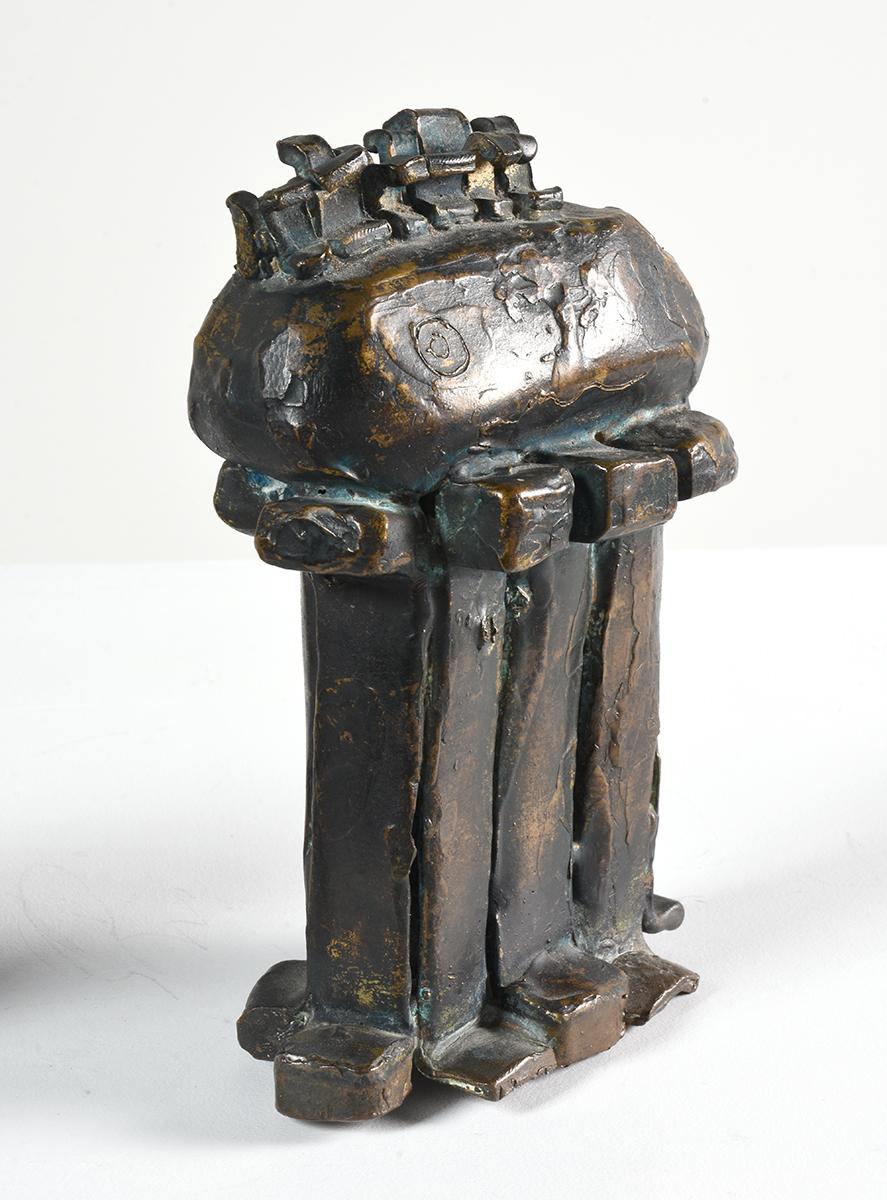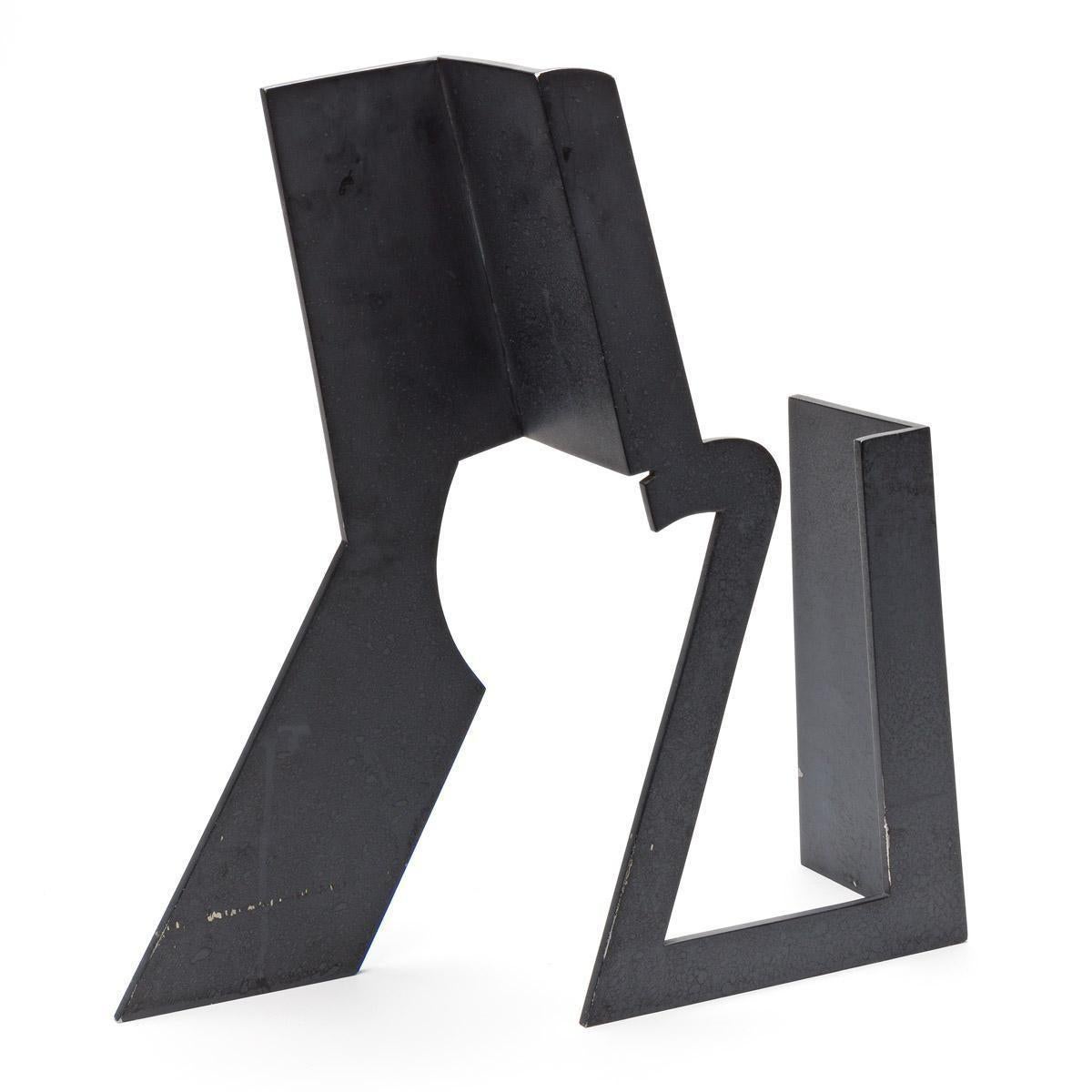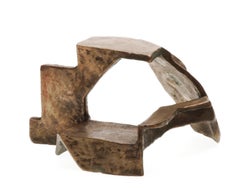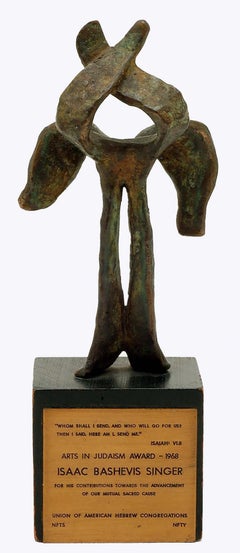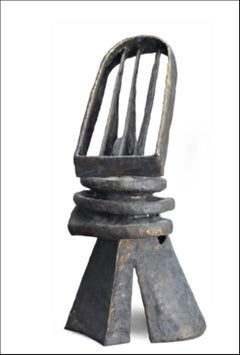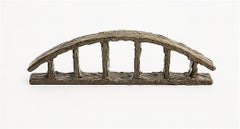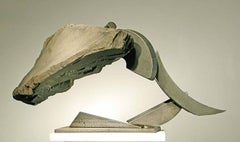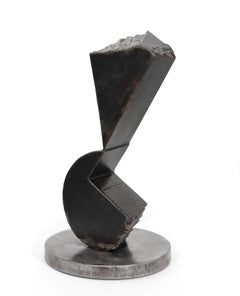Items Similar to Untitled signed sculpture, from the collection of Dick Polich, Tallix Foundry
Want more images or videos?
Request additional images or videos from the seller
1 of 5
Stephen TalasnikUntitled signed sculpture, from the collection of Dick Polich, Tallix Foundryca. 1997
ca. 1997
$2,800
£2,179.99
€2,479.27
CA$4,028.53
A$4,425.16
CHF 2,312.62
MX$52,773.74
NOK 29,284
SEK 27,280.51
DKK 18,526.30
About the Item
Stephen Talasnik
Untitled sculpture, from the collection of Dick Polich, Tallix Foundry, ca. 1997
Cast light metal
signed by the artist on the work (see close up photograph)
6 3/5 × 12 × 4 inches
Provenance
Estate of Dick Polich, founder of the legendary Tallix Foundry and Polich Art works Beacon, NY
Manufacturer
Stephen Talasnik at Tallix Foundry, Beacon, New York
This work is signed by the artist (see close up photograh)
Abstract metal sculpture
The work is lightweight so it is believed to be in aluminum or an aluminum alloy,
Provenance: acquired from the Estate of Dick Polich - founder of the legendary Tallix foundry and Polich Art Works.
Polich and Tallix fabricated significant sculptural works over many years, collaborating with such as, Willem de Kooning, Jeff Koons, Roy Lichtenstein, Frank Stella, Helen Frankenthaler, ERTE, Julian Schnabel, Richard Artschwager, Isamu Noguchi, Isaac Witkin, John Chamberlain, Louise Nevelson, Tom Otterness and many others.
Stephen Talasnik refers to himself as a "Dysfunctional architect, improvisational builder, fictional engineer"
Stephen Talasnik Biography:
Stephen Talasnik was born in Southwest Philadelphia. He grew up in a working class neighborhood surrounded by oil refineries, shipyards, an airport, and a cemetery. As a child, he built roller coasters out of toothpicks, futuristic model cities out of discarded radio and television parts, and skyscrapers out of household product containers. One of his favorite childhood memories was watching the Goodyear blimp make an emergency landing in the local cemetery a block from his house.
Talasnik is a graduate of the prestigious Central High School in Philadelphia, Rhode Island School of Design (BFA), and the Tyler School of Art (MFA). As a student at RISD, he came in contact with two instructors who would have a profound influence on his ongoing studio investigation of drawing. Photographers Harry Callahan and Aaron Siskind lectured on the aesthetics of black and white and introduced Talasnik to the graphic works of Seurat and Giocometti. After completing his graduate study at Tyler (Rome and Philadelphia campuses), he relocated to the Jersey Shore where he was employed as a window decorator on the Boardwalk and a political cartoonist for the local newspaper.
Appointed Exhibitions Coordinator at the Fleisher Art Memorial, he spent the next 6 years living in Philadelphia. Eventually he left the US spending 3 years in Tokyo, Japan, teaching Drawing, Design, and Art History at Temple University’s branch campus. He traveled extensively throughout China, Thailand, and The Philippines studying the craft of home spun engineering that utilized indigenous natural materials. He observed farmers build bridges, irrigation systems, and houses with reed, bamboo, and vine.
After returning to the US, he settled in New York City. His drawings were shown and collected primarily in Europe, including the Albertina, British Museum, and State Museum of Art, Berlin. In the summer of 2001, he started to make sculpture; small scale structures that enlisted the language of architectural model making. His first major installation was a commission from the Japan Society in NYC, invited as the lone non Asian participant in a survey of contemporary Bamboo Art. His first large scale, outdoor commission was from the Storm King Art Center in Mountainville, NY when he designed and built “Stream”, a temporary site specific bamboo structure covering three acres that survived an earthquake, hurricane, and a winter of one of the worst snowfalls in recorded history in the Hudson Valley. In recent years, his work has been added to the collections of the Metropolitan Museum of Art, NY; National Gallery of Art, Washington DC; the Pompidou (Paris), and the Whitney Museum of American Art, NY to name a few.
He continues to build and draw in NYC.
About Stephen Talasnik:
Stephen Talasnik’s drawing and sculpture explore otherworldly landscape and objects that evoke childhood memories. Originally from Philadelphia, Talasnik grew up in an urban neighborhood surrounded by oil refineries, a shipyard, a helicopter factory, and an airport, immersing him in the aesthetics of industrial building. He lived in a house that bordered a local creek, providing him an opportunity to unearth the past as he searched for fossils imbued with fictional narratives. He turned these experiences into a world explored through drawing with pencil and building complex structures from wood.
Talasnik has spent the better part of sixty years inventing the past and envisioning and documenting the future. Often defined as “Fictional Engineering”, he uses no system of measurement, relying on the aesthetics of intuition and invention. He has built roller coasters out of toothpicks, drawn visionary spaceships, and constructed entire cities out of found objects.
Working in his Brooklyn studio and ever informed by intuitive engineering and the human form, Talasnik continues to explore the unlimited capacity of the fictional object and landscape. Seduced by a visionary’s mantra, he relies on his personal encyclopedia of experience to define an imagined world that explores the visual capacity of a self-defined beauty. Archeological in nature, the viewer is invited to examine a personalized lexicon; extracting clues but challenged to determine specific identity. Employing pencil or wood, Talasnik’s works must always suggest the unfinished yet complete.
Talasnik attended the Rhode Island School of Design (BFA) where he studied Black and White theory with photographers Aaron Siskind and Harry Callahan, who nurtured his passion for drawing. His graduate studies took him to Rome with the Tyler School of Art (MFA) where he drew both the human form and architecture from the Classical environment. After completing his formal studies, Talasnik moved to Tokyo where he spent three years. It was in Tokyo that a fascination with hand building re-emerged after studying the art of bamboo construction. Following his time in Japan, Talasnik spent ten years traveling through Asia, all while commuting to his studio in New York City. These seminal experiences inform Talasnik’s obsession with drawing and building landscapes and objects that defy time or place.
In 2010, Talasnik ventured into the world of land art, and has completed major installations at the Storm King Art Center (NY); the Tippet Rise Art Center (MO); the Denver Botanic Garden (CO); the Russel Wright Design Center (NY); and Architektur Galerie Berlin. Talasnik has maintained ongoing studio investigations while exhibiting internationally. His work has been acquired by the Metropolitan Museum of Art (NY); the Albertina (Vienna); the British Museum (London); the National Gallery of Art (DC); the Pompidou Centre (Paris); and the Whitney Museum (NY) among others. Talasnik lives and works in Brooklyn, NY.
Courtesy of Maya Frodeman Gallery
- Creator:Stephen Talasnik (1954, American)
- Creation Year:ca. 1997
- Dimensions:Height: 6.6 in (16.77 cm)Width: 12 in (30.48 cm)Depth: 4 in (10.16 cm)
- Medium:
- Movement & Style:
- Period:
- Condition:Very Good; minor oxidation (see photos) otherwise appears very good.
- Gallery Location:New York, NY
- Reference Number:1stDibs: LU1745214091302
About the Seller
5.0
Platinum Seller
Premium sellers with a 4.7+ rating and 24-hour response times
Established in 2007
1stDibs seller since 2022
463 sales on 1stDibs
Typical response time: 2 hours
- ShippingRetrieving quote...Shipping from: New York, NY
- Return Policy
More From This Seller
View AllAbstract Bronze Sculpture, Unique Signed work from the estate of Arthur Carr
By Peter Reginato
Located in New York, NY
Peter Reginato
Abstract Bronze Sculpture, ca. 1987
Bronze
Signed on the underside
4 × 6 1/2 × 5 1/2 inches
This bronze sculpture is by the American abstract sculptor Peter Reginato. ...
Category
1980s Abstract Abstract Sculptures
Materials
Bronze
Bronze Sculpture to Isaac Bashevis Singer, Arts in Judaism Award signed Judaica
By Nathaniel Kaz
Located in New York, NY
Nathaniel Kaz
Bronze Sculpture to Isaac Bashevis Singer for Arts in Judaism Award, 1966
Bronze, Square wooden base, Metal tag
Signed and dated "66" to back of bronze portion of the w...
Category
1960s Abstract Expressionist Abstract Sculptures
Materials
Metal, Bronze
Maquette for Laureate (unique sculpture)
By Seymour Lipton
Located in New York, NY
Seymour Lipton
Maquette for Laureate, ca. 1968-1969
Nickel silver on monel metal
Unique
18 × 8 1/2 × 7 inches
Marlborough-Gerson Gallery, New York
Acquired from the above by the previous owner, 1969
thence by descent
Christie's New York: Monday, June 30, 2008 [Lot 00199]
Acquired from the above Christie's sale This unique sculpture by important Abstract Expressionist sculptor Seymour Lipton is a maquette of the monumental sculpture "Laureate" - one of Lipton's most iconic and influential works located on the Riverwalk in downtown Milwaukee, Wisconsin. Laureate is a masterpiece that was commissioned by the Allen-Bradley Company in memory of Harry Lynde Bradley and as an enhancement for the newly constructed Performing Arts Center. It is located on the east bank of the Milwaukee River at 929 North Water Street. The Bradley family in Milwaukee were renowned patrons of modernist sculpture, known for their excellent taste who also founded an eponymous sculpture park. For reference only is an image of the monumental "Laureate" one of Milwaukee's most beloved public sculptures. According to the Smithsonian, which owns a different unique variation of this work, "The full-size sculpture Laureate was commissioned by the Marcus Center for the Performing Arts in Milwaukee. In the initial drawings, Seymour Lipton combined details from the architectural plan with a wide variety of images, ranging from musical instruments to a lighthouse on the island of Tobago. He transformed the basic shapes from these sketches into a welded sculpture, which evokes a figure composed of columns, harp strings, and coiled rope. Lipton created this piece to celebrate achievement in the arts. The dramatic silhouette commands your attention, reflecting the title Laureate, which means worthy of honor and distinction. The final version of the piece is over twelve feet high and stands out against the pale, flat buildings of the arts center.,,"
Provenance
Marlborough-Gerson Gallery, New York
Acquired from the above by the previous owner, 1969
thence by descent
Christie's New York: Monday, June 30, 2008 [Lot 00199]
Acquired from the above Christie's sale
About Seymour Lipton:
Born in New York City in 1903, Seymour Lipton (1903-1986) grew up in a Bronx tenement at a time when much of the borough was still farmland. These rural surroundings enabled Lipton to explore the botanical and animal forms that would later become sources for his work. Lipton’s interest in the dialogue between artistic creation and natural phenomena was nurtured by a supportive family and cultivated through numerous visits to New York’s Museum of Natural History as well as its many botanical gardens and its zoos. In the early 1920s, with the encouragement of his family, Lipton studied electrical engineering at Brooklyn Polytechnic Institute and pursued a liberal arts education at City College. Ultimately, like fellow sculptor Herbert Ferber, Lipton became a dentist, receiving his degree from Columbia University in 1927. In the late 1920s, he began to explore sculpture, creating clay portraits of family members and friends.
In addition to providing him with financial security, dentistry gave Lipton a foundation in working with metal, a material he would later use in his artwork. In the early 1930s, though, Lipton’s primary sculptural medium was wood. Lipton led a comfortable life, but he was also aware of the economic and psychological devastation the Depression had caused New York. In response, he generally worked using direct carving techniques—a form of sculpting where the artist “finds” the sculpture within the wood in the process of carving it and without the use of models and maquettes. The immediacy of this practice enabled Lipton to create a rich, emotional and visual language with which to articulate the desperation of the downtrodden and the unwavering strength of the disenfranchised. In 1935, he exhibited one such early sculpture at the John Reed Club Gallery in New York, and three years later, ACA Gallery mounted Lipton’s first solo show, which featured these social-realist-inspired wooden works. In 1940, this largely self-taught artist began teaching sculpture at the New School for Social Research, a position he held until 1965.
In the 1940s, Lipton began to devote an increasing amount of time to his art, deviating from wood and working with brass, lead, and bronze. Choosing these metals for their visual simplicity, which he believed exemplified the universal heroism of the “everyman,” Lipton could also now explore various forms of abstraction. Lipton’s turn towards increasing abstraction in the 1940s allowed him to fully develop his metaphorical style, which in turn gave him a stronger lexicon for representing the horrors of World War II and questioning the ambiguities of human experience. He began his metal work with cast bronze sculptures, but, in 1946, he started welding sheet metal and lead. Lipton preferred welding because, as direct carving did with wood, this approach allowed “a more direct contact with the metal.”[ii] From this, Lipton developed the technique he would use for the remainder of his career: “He cut sheet metal, manipulated it to the desired shapes, then joined, soldered, or welded the pieces together. Next, he brazed a metal coating to the outside to produce a uniform texture.”[iii]
In 1950, Lipton arrived at his mature style of brazing on Monel metal. He also began to draw extensively, exploring the automatism that abstract expressionist painters were boasting at the time. Like contemporaries such as Jackson Pollock, Lipton was strongly influenced by Carl Jung’s work on the unconscious mind and the regenerative forces of nature. He translated these two-dimensional drawings into three-dimensional maquettes that enabled him to revise his ideas before creating the final sculpture.The forms that Lipton produced during this period were often zoomorphic, exemplifying the tension between the souls of nature and the automatism of the machine.
In the years following the 1950s, Lipton’s optimism began to rise, and the size of his work grew in proportion. The oxyacetylene torch—invented during the Second World War—allowed him to rework the surfaces of metal sculptures, thus eliminating some of the risks involved with producing large-scale finished works. In 1958, Lipton was awarded a solo exhibition at the Venice Biennale and was thus internationally recognized as part of a small group of highly regarded avant-garde constructivist sculptors. In 1960, he received a prestigious Guggenheim Award, which was followed by several prominent public commissions, including his heroic Archangel, currently residing in Lincoln Center’s David Geffen Hall.
A number of important solo exhibitions of his work followed at The Phillips Collection in Washington, DC (1964); the Milwaukee Art Center and University of Wisconsin, Milwaukee (1969); the Virginia Museum of Fine Arts in Richmond (1972); the Everson Museum in Syracuse, NY (1973); the Herbert E. Johnson Museum of Art of Cornell University in Ithaca, NY (1973); the National Collection of Fine Arts, Smithsonian Institution (now the Smithsonian American Art Museum) in Washington, DC (1978); and a retrospective in 1979 at The Jewish Museum in New York. In 1982 and 1984 alone, two exhibitions of his sculpture, organized respectively by the Mint Museum (Charlotte, NC) and the Hillwood Art Gallery of Long Island University (Greenvale, NY), traveled extensively across museums and university galleries around the nation. In 2000, the traveling exhibition An American Sculptor: Seymour Lipton was first presented by the Palmer Museum of Art of Pennsylvania State University in University Park. Most recently, in 2009, the Ackland Art Museum in Chapel Hill, NC mounted The Guardian and the Avant-Garde: Seymour Lipton’s Sentinel II in Context.
Since 2004, Michael Rosenfeld Gallery has been the exclusive representative of the Estate of Seymour Lipton and has presented two solo exhibitions of his work—Seymour Lipton: Abstract Expressionist Sculptor (2005) and Seymour Lipton: Metal (2008). In 2013, Michael Rosenfeld Gallery presented Abstract Expressionism, In Context: Seymour Lipton, which included twelve major sculptures by the artist, along with works by Charles Alston, Norman Bluhm, Beauford Delaney, Willem de Kooning, Jay DeFeo, Michael Goldberg, Adolph Gottlieb, Hans Hofmann, Lee Krasner, Norman Lewis, Conrad Marca-Relli, Boris Margo, Alfonso Ossorio, Richard Pousette-Dart, Milton Resnick, Charles Seliger...
Category
1960s Abstract Expressionist Abstract Sculptures
Materials
Metal, Silver
The Promise, original signed bronze sculpture by renowned British - US sculptor
Located in New York, NY
William Tucker
The Promise, ca. 1980
Bronze
Signed and numbered 5/6 - incised on the metal
2 5/8 × 8 5/8 × 1 inch
This abstract sculpture is by the renowned modern British born sculp...
Category
1980s Abstract Abstract Sculptures
Materials
Bronze
Famed sculptor Nancy Graves unique signed patinated bronze sculpture NY Award
By Nancy Graves
Located in New York, NY
Nancy Graves
New York State Governor's Arts Award, 1988
Bronze, polychrome patina and baked enamel on base with Award plaque
10 1/4 × 7 × 10 1/4 inches
Hand signed and dated with inc...
Category
1980s Abstract Expressionist Abstract Sculptures
Materials
Enamel, Bronze
$16,800 Sale Price
40% Off
Welded Brushed Steel Sculpture - geometric abstraction (Unique, signed)
By Michael Todd
Located in New York, NY
Michael Todd
Welded Brushed Steel Sculpture - geometric abstraction, 1968
Welded Brushed Steel
Hand signed and dated 1968 in marker on surface....
Category
1960s Abstract Geometric Abstract Sculptures
Materials
Steel
You May Also Like
John Van Alstine - FLECHE, Sculpture 2005
By John Van Alstine
Located in Stamford, CT
Slate, Steel
Stone and metal, usually granite or slate and found object steel are central in my sculpture. The interaction of these materials is a major focus. On the most basic lev...
Category
Early 2000s Abstract Abstract Sculptures
Materials
Stone, Slate, Steel, Cut Steel, Stainless Steel
Untitled abstract expressionist mid-century modern sculpture
By Thomas Morin
Located in Wilton Manors, FL
Thomas Morin (1934-2017)
Untitled, 1962.
Cast iron on wood base. Cast sculpture measures 24 x 7 x 5 inches and weighs 49 lbs. Overall measures 26 inches tall on wood base.
Proc...
Category
Mid-20th Century Abstract Expressionist Abstract Sculptures
Materials
Iron
$2,400 Sale Price
40% Off
Noteworthy - Original Contemporary Expressive Geometric Abstract Metal Sculpture
By Granville Beals
Located in Los Angeles, CA
Inspired by dance and weightlessness, Granville Beals' industrial metal sculptures are primarily about relationships. Concerned with form and abstraction, he does not merely manipula...
Category
21st Century and Contemporary Abstract Abstract Sculptures
Materials
Metal, Steel
George Curtis Abstract Aluminum Sculpture
Located in Tarrytown, NY
1960s George Curtis aluminum sculpture formed with potatoes entitled Red Sea Smoke.
Category
Vintage 1960s Abstract Sculptures
Materials
Aluminum
Eugene Caples "Bronze Sculpture II" Abstract Bronze Sculpture
By Eugene Caples
Located in Detroit, MI
This small exquisite "Bronze Sculpture II" is in excellent condition and a perfect example of Eugene Caples craftsmanship. This is mainly abstract with some graphic or architectural elements and is so delightful that mythical creatures demand to be considered. It cries out to be touched and held, looked at and caressed. The beautiful patina on the surface gives voice to the many hands that have done these things.
Eugene Caples is a designer and craftsman who worked in Kansas City in the 1960s and later through the early 21st century. He attended the Kansas City Art Institute, earning his Bachelors of Fine Arts in Industrial Design in 1959. In 1963 he was accepted to Cranbrook Academy of Art, Bloomfield Hills, Michigan. The Cranbrook Academy of Art was designed by architect and faculty member, Eliel Saarinen who collaborated with Charles and Ray Eames on chair and furniture design. Numerous creative artists are alumni of Cranbrook and include: Harry Bertoia, Florence Knoll, Jack Lenor Larsen, Donald...
Category
Late 20th Century American Modern Abstract Sculptures
Materials
Bronze
"Roland, " George Sugarman, Abstract Steel Sculpture
By George Sugarman
Located in New York, NY
George Sugarman (1912 - 1999)
Roland, 1970
Patinated steel
17 3/8 x 16 x 5 1/4 inches
Incised with the artist's signature and numbered "15/17" on the underside
Manufactured by Lippin...
Category
1970s Abstract Abstract Sculptures
Materials
Steel
More Ways To Browse
Vintage Metal Sculptures Signed
Used Toothpicks
Retro Russel Wright
Roy Lichtenstein This Must Be The Place
Granite Plinth
Grant Levy Lucero
Gun Metal Sculpture
Henry Moore Maquette
Imilac Meteorite
Jeff Gillmor
Jesus Jeans
Jesus Moroles
Joe Feddersen
John Bisbee
Jon Isherwood
Kan Yasuda
Kay Walkingstick
Korean Triptych
